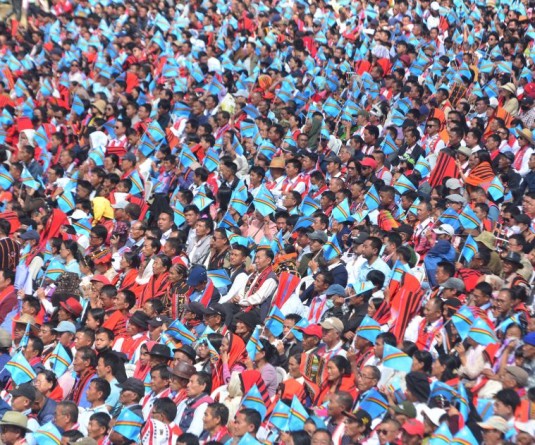
Gen (Retd) Thepuneyi Rhakho
President, Federal Government of Nagaland Naga National Council
For far too long, our people have endured the pains of division and strife. We have been fragmented by borders and boundaries, by ideologies and interests which had immensely hindered efforts towards unity. Additionally, external pressures and geopolitical dynamics have further complicated the path to liberation.
On top of that, against the wishes of the Naga people, Government of India has decided to divide us further by scrapping the Free Movement Regime (FMR) agreement with Myanmar and build a fence in the middle of our territory. The occupational forces have no right to do that and we shall stand strong together against it. We will not allow that to happen.
At its core, the free movement regime embodies the spirit of openness and cooperation. It recognizes the inherent ties that bind the Naga people across artificial borders and seeks to facilitate seamless interaction and exchange. By removing barriers to movement, individuals and communities are empowered to reconnect with long-lost relatives, engage in trade and commerce, and participate in cultural and religious events without hindrance.
It allows Naga people to freely engage in traditional practices, celebrate festivals, and preserve their unique heritage without fear of restrictions or discrimination. Cultural exchange flourishes as individuals from different Naga tribes and sub-tribes come together to share their customs, languages, and stories, enriching the collective tapestry of Naga identity.
So, taking this opportunity, I would also like to appeal to our esteemed eastern Naga brothers and sisters of Nagaland state to come together as one people and one nation under one flag and one constitution to which we all look up with pride and humility. We are all proud to be Nagas but ashamed to be Indians actually. Therefore, let us not bring division amongst us. This is a time for integration not disintegration.
Nationhood is not merely a geographical construct; it is the collective consciousness of a people bound by a common heritage and a shared destiny. It is the recognition that our diversity is our strength and our unity is our power.
To build Naga nationhood, we must first acknowledge and embrace our differences. We come from diverse tribes, each with its own traditions, languages, and customs. But in our diversity lies our richness, and it is this richness that we must celebrate and preserve.
At the same time, we must also recognize our shared history and common aspirations. We are united by our struggle for self-determination, by our yearning for peace and prosperity, and by our commitment to justice and equality for all.
Building Naga nationhood requires us to transcend the narrow confines of tribe and group’ ism or factionalism and to embrace the larger identity of being Naga. It requires us to rise above petty grievances and partisan politics, and to work together for the greater good of our people.
As we embark on this journey towards nationhood, let us draw inspiration from the sacrifices of those who have come before us. Let us honor the memory of our forefathers who fought and died for the cause of Naga freedom. And let us recommit ourselves to the principles of non-violence, justice, equality, and democracy that they held dear. We all acknowledge that there has been some terrible mistakes in our journey but let’s not let those mistakes hinder us to achieve our goal. Instead, let us pick up from where we left off and race up to the finish line. Let us pass on the same old baton. Let us not create or make another baton to blind or bind ourselves. Enough is enough. So, Come! Let us take it to the end with what we have started in the beginning. Let us not dilute our history. Let us base our unity on our historical rights and our historical facts with our historical achievements. We will not take what is not ours nor shall we give up what is ours.
By forging a spirit of liberation rooted in shared identity and common goals, the Naga people can overcome internal divisions and external challenges. It is time for the Naga people to come together as one, drawing strength from their diversity and solidarity as they march towards a future of autonomy and dignity.
In conclusion, let us remember that the task of building Naga nationhood is not easy, nor is it quick. It requires patience, perseverance, and above all, unity of purpose. If we stand together as one people, united in our commitment to a better future, there is no challenge that we cannot overcome.
Thank you and Kuknalim
God bless Nagaland.




